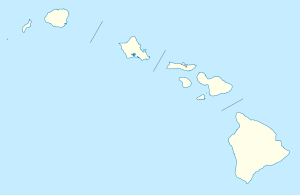Haleki'i-Pihana Heiau State Monument
|
Halekiʻi-Pihana Heiau | |
|
View from bridge over ʻIao Stream | |
 | |
| Location | Hea Pl. off Kuhio Pl. from Waiehu Beach Rd. |
|---|---|
| Nearest city | Wailuku, Hawaii |
| Coordinates | 20°54′30″N 156°29′42″W / 20.90833°N 156.49500°WCoordinates: 20°54′30″N 156°29′42″W / 20.90833°N 156.49500°W |
| Area | 10-acre (4.0 ha) |
| NRHP Reference # | 85002972 |
| Added to NRHP | 25 November 1985[1] |
Halekiʻi-Pihana Heiau State Monument is a 10-acre (4.0 ha) park containing two important luakini heiau on a high ridge near the mouth of ʻIao Stream in Wailuku, Maui. Both Halekiʻi and Pihana were associated with important Hawaiian chiefs, have been closely studied by archaeologists,[2] and overlook the fertile Nā Wai ʻEhā ('Four Waters') region irrigated by the Wailuku, Waikapu, Waiheʻe and Waiehu streams.[3] The heiau complex was added to the National Register of Historic Places on 25 November 1985.[1]
Pihana ('fullness' or 'gathering') is also known as Piihana and Pihanakalani ('gathering of the supernatural').[4] It began as a small temple site between 1260 and 1400, was expanded between 1410 and 1640 to serve as a residence and luakini (war/sacrificial) temple for Kiʻihewa, who lived at the time of Kakaʻe, the father of Kahekili I.[2]
Halekiʻi ('image house' or "Tiki House") was added along the crest of the hill at about this time, reputedly at the instigation of chief Kihapiʻilani. Both were greatly expanded into their present shape between 1662 and 1705, and Pihana was enhanced and reoriented to face the island of Hawaiʻi during a period of interisland warfare between 1684 and 1778. In 1790, after the forces of Kamehameha I won the very deadly Battle of Kepaniwai,[5] his son Liholiho rededicated Pihana.[2]
See also
References
- 1 2 National Park Service (2007-01-23). "National Register Information System". National Register of Historic Places. National Park Service.
- 1 2 3 Kirch, Patrick Vinton (1996). "Halekiʻi–Pihana Heiau". Legacy of the Landscape: An Illustrated Guide to Hawaiian Archaeological Sites. Honolulu: University of Hawaii Press. pp. 66–67. ISBN 0-8248-1739-7.
- ↑ Harry Eagar (14 March 2008). "Na Wai Eha designated: State commission to require permits for the water's users". The Maui News. Retrieved 2010-03-31.
- ↑ "Hawaiian Dictionaries". Retrieved 2010-03-31.
- ↑ "Temples of the Chiefs". Maui Attractions Newsletter. March 2003.
